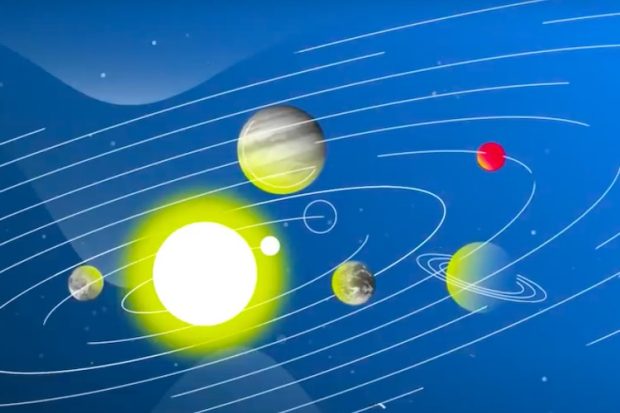Potentially Habitable Planets
Astrophysicist Joshua Winn on astronomical transits, the importance of liquid water, and Kepler mission
videos | August 13, 2015
How do scientists search for planets that are hospitable for life? What are the key properties for life to be possible? How to detect an Earth-like planet orbiting a distant star? These and other questions are answered by Associate Professor of Physics at MIT Joshua Winn.
An exoplanet is a planet that orbits a distant star rather than orbiting the Sun. And one of the big reasons why this field has gathered so much attention, so much excitement both from professionals and from just interested people is because of the quest for life on other planets. We would all like to know: are there other living beings elsewhere in the Galaxy?
There are lot of ways to try and answer that question, but surely one of the first things you’d like to do is find the planets that seem hospitable to life. And our starting point for that is the Earth. The Earth is the only planet where we know life has arisen. And even though we don’t really understand how life arose here, at least we know that it did happen here. And so as we go looking for life in the Universe, we should probably give at least a first priority to those planets that resemble the Earth in what we think are the key respects that were important for life.
And so our working definition for a “potentially habitable planet” is that it should be about the same size and mass as the Earth, that is, it should be a rocky planet, a planet with a solid surface, that could potentially have oceans and places for life to start. And it should be about the right temperature, it should be roughly the same temperature as the Earth. And specifically it should be over temperature where water could exist as a liquid, the basic idea being that at least on Earth water is essential for every form of life we’ve ever discovered, and so our working hypothesis for lack of a better one is that in looking for life we should look for liquid water..

Finding planets like that is very challenging. It’s much easier to find giant planets like Jupiter and Saturn, but such planets, we think, are not hospitable to life. They’re mostly made of hydrogen and helium, and most of that hydrogen and helium exists at very high pressures and densities, because those planets are so massive. So that we, at the moment at least, can’t imagine there being living creatures on those planets.
To find Earth-like planets is very challenging, and it’s only been in the last ten years or so that we’ve been at all even close to being able to detect Earth-like planets. A big breakthrough happened with the NASA Kepler Mission. The Kepler Mission was the first one that was really very sensitive to Earth-sized planets. And the way that it found Earth-sized planets is by launching a space telescope, like the Hubble Telescope, but with a very single-minded approach.
Instead of just observing any old thing in the galaxy, all that the Kepler Telescope did was monitored the brightnesses of about 200 000 selected stars in a patch of the sky. And it was looking for eclipses, it was looking for those rare cases when a planet’s orbit would take it in front of the star and thereby block a small portion of the light from that star which we would register with the Kepler telescope as a slight dip in the brightness of the star over a course of a few hours or a day every time the planet went around. And the camera that was built for the Kepler telescope was precise enough and the telescope was large enough to allow for those precise measurements so that it could find eclipses, changes in brightness as small as 10 parts per million which is plenty sensitive enough to detect the eclipse of an Earth-like planet around a star like the Sun. So over the course of four and a half years Kepler monitored the brightnesses of these several hundred thousand stars and did find lots of examples of Earth-sized and larger planets orbiting those stars.
Earth-sized is one of our criteria for being potentially habitable.
The other criterion is that it has to be the right temperature. It can’t be too close or too far away from the star. If it’s too close, water could not possibly exist as a liquid, and if it’s too far away, it likely is frozen out on the surface of any planet. So you have to find planets that are about the right distance from their stars, and that means for a star like the Sun the planet should be in an Earth-like orbit. It should take about a year for that planet to go around, that’s when it would be in the right distance, in the so-called “habitable zone” of its star.
That is much more difficult. You’re much more likely to see eclipses of planets that are very close to their stars. A planet that’s very close to its star is just much more likely to be seen in eclipse. There is much more tolerance in the orientation of its orbit that would allow for eclipses if the planet is close in than if the planet’s very far away from the star and it requires an extreme coincidence for the orbit to be oriented exactly so that the planet eclipses its star. So for every Earth-like planet in an Earth-like orbit that Kepler could detect, it could detect hundreds of thousands of closer in planets. The Earth-like planets in the habitable zone are really just the tip of the iceberg compared to the huge numbers of planets that Kepler detected closer to their stars, the planets that were thought to be too hot for life.
Nevertheless, Kepler has found at least a few examples of planets that are plausibly potentially habitable. They are about the right distance from their stars and seem to be about the right size for them to have solid surfaces and therefore potential abodes for life. I think it’s fair to say that none of them are exactly like the Earth in the sense that some of these potentially habitable planets are actually closer in to their stars than the Earth is to the Sun, but the star itself is also less luminous than the Sun. And so even though the planet is closer in, the temperature still may be about right, the radiation is not quite as intense from their star as it would be from the Sun in the same orbit.
Kepler has taken us really right to the threshold of finding truly Earth-like planets in Earth-like orbits around Sun-like stars. The concept of the habitable zone is really just our attempt to decide what to try first. We know that we don’t understand how life arose on the Earth, we don’t know what were the necessary conditions for life to arise, and we don’t know what were the sufficient conditions for life to arise. So when looking for life elsewhere in the galaxy, if we keep a completely open-mind and say anything is possible, we have no basis for a specific search, we don’t even know what to do first.

But when we decide how to allocate our resources, our telescope time, when we try to decide what types of instruments we should build, what types of satellite missions we should undertake, our first guess is that we should be looking for planets that resemble the Earth in as many parameters as we can manage.
To find truly Earth-like planets around Sun-like stars in Earth-like orbits is going to take time. Kepler has taken us right to the threshold of that discovery. To take the next step and find such planets around stars in our neighborhood of the galaxy and to make images of those planets – that’s a task for the next several decades to come and will probably take the form a very ambitious space mission that’s capable of doing very high contrast imaging of nearby stars to look for Earth twins.
On the other hand, there might be a shortcut. The shortcut would be to give up on finding Earth-like planets around Sun-like stars that is a star that’s just the same mass, and brightness, and luminosity as the Sun. But instead to settle for stars that are much fainter, much less luminous, much redder and colder. And the reason why that’s a shortcut is if you have a star like that, that’s not putting out nearly as much heat, then you can put a planet very much closer to that star and still have it be the right temperature for liquid water, to have it be a similar temperature to the Earth. And if you have a planet in a very close, tight orbit it just makes it much easier to study. Each orbital period might take only a few days or weeks, and so gathering the necessary data to show that it’s a planet, and to measure its mass, and to measure its size – those tasks are all made much easier if the planet is closer in.
So there are a number of us who have taken to searching specifically around low mass, low luminosity, cold stars for close in planets that may nevertheless be potentially habitable.
So one such project would be a successor mission to the Kepler Mission which is called TESS, the Transiting Exoplanet Survey Satellite.
TESS, like Kepler, would search hundreds of thousand of stars for the tiny eclipses that would be caused by orbiting planets.
But TESS would do so a little differently. TESS would examine all the nearest brightest stars over the entire sky rather than a relatively narrow field of somewhat faint stars, which is what Kepler did.
The big trade-off is that Kepler really wanted to find Earth-like planets in Earth-like orbits around Sun-like stars, and that means that each eclipse happens once per year as the planet wheels around the star in a one-year orbit. TESS is going to be different. TESS is only going to examine stars for a time interval ranging from a month to a year. So it’s not going to see multiple eclipses of an Earth-like planet, instead it will see multiple eclipses from planets that are closer in. It may nevertheless find planets that are potentially habitable if it looks around a sufficient number of colder, less luminous stars.
We expect that TESS will find nearly as many potentially habitable planets as the Kepler Mission did. It’s just that it will find them around stars that are much fainter and colder than the Sun.
The quest for life on other planets is one of those questions that has occurred to everyone at some time or another in their lives whether they are scientists or not. And I think what feeds us with energy and enthusiasm in exoplanetary science is that everybody correctly senses that we are actually making progress on this age-old quest.
We haven’t found life on other planets, it’s going to be some time before we can make any definitive statement one way or the other, but at least we’re finding the planets around which life could exist. And we’re starting to think about specific ways that we can interrogate those planets to search for signs of life. And I think that’s the most exiting thing about the decades to come that we have to look forward to in exoplanetary science.





























